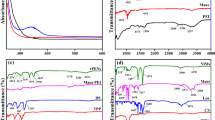Abstract
Rifampin microspheres were prepared by spray drying using either polylactic acid (PLA) or poly(lactic-co-glycolic acid) (PLGA) polymers in different drug to polymer ratios (90:10 to 5:95, w/w). The in-vitro release characteristics, particle-size distribution, and cytotoxicity (in an alveolar macrophage cell line) and pharmacokinetics in rats after pulmonary instillation were evaluated. Increasing the polymer content from 10% to 95% slowed down the in vitro drug release with PLGA particles showing a steeper change with increasing polymer content (100% to 20% drug release over 6 h) than PLA particles (88% to 42% drug release over 6 h). PLA microsphere formulations revealed lack of cytotoxicity and a mass median aerodynamic diameter (MMDA) of 2.22–2.86 μm, while PLGA particles were larger (MMDA of 4.67–5.11 μm). Pharmacokinetics differed among the formulations with the 10% PLA formulation showing a distinct sustained release (t max of 2 h vs 0.5 h of free drug) and a systemic bioavailability similar to that of free drug. Formulations with high polymer content showed a lower relative bioavailability (30%). This suggested that an optimal release rate existed for which a distinct amount of drug was delivered over an extended period of time.






Similar content being viewed by others
References
Tuberculosis Worldwide. Health Protection Agency, 2006; http://www.hpa.org.uk/infections/topics_AZ/tb/worldwide.htm.
E. L. Barrow, G. A. Winchester, J. K. Staas, D. C. Quenelle, and W. W. Barrow. Use of microsphere technology for targeted delivery of rifampin to Mycobacterium tuberculosis-infected macrophages. Antimicrob Agents Chemother. 42:2682–2689 (1998).
S. Connett. TB sourcebook. The complete tuberculosis resource, American Health Consultants, Georgia, 1997.
WHO. World Health Organization Factsheet N104, March 2006. http://www.who.int/mediacentre/factsheets/fs104/en/print.html.
J. D. Grodon. Antituberculous therapy. In L. I. Lutwick (ed.), Tuberculosis. A clinical handbook, Chapman & Hall, New York, 1995, pp. 295–316.
E. Mutschler, and H. Derendorf. Drug Actions. Basic principles and therapeutic aspects, CRC, Ann Arbor, MI, 1995.
P. E. Patterson, M. E. Kimerling, W. C. Bailey, and N. E. Dunlap. Chemotherapy of tuberculosis. In D. Schlossberg (ed.), Tuberculosis and nontuberculous mycobacterial infections, W.B. Saunders Co, PA, 1999, pp. 71–82.
L. N. Friedman. Pulmonary tuberculosis: presentation, diagnosis and treatment. In L. N. Friedman (Ed), Tuberculosis: Current concepts and treatment. CRC, New York, 2001, pp 107–138.
D. A. Mitchison. Basic mechanisms of chemotherapy. Chest. 76(6 Suppl):771–781 (1979).
P. R. Byron. Prediction of drug residence times in regions of the human respiratory tract following aerosol inhalation. J Pharm Sci. 75:433–438 (1986).
S. Suarez, R. J. Gonzalez-Rothi, H. Schreier, and G. Hochhaus. Effect of dose and release rate on pulmonary targeting of liposomal triamcinolone acetonide phosphate. Pharm Res. 15:461–465 (1998).
D. A. Edwards, J. Hanes, G. Caponetti, J. Hrkach, A. Ben-Jebria, M. L. Eskew, J. Mintzes, D. Deaver, N. Lota, and R. Langer. Large porous particles for pulmonary drug delivery. Science. 276:1868–1871 (1997).
R. Vanbever, J. D. Mintzes, J. Wang, J. Nice, D. Chen, R. Batycky, R. Langer, and D. A. Edwards. Formulation and physical characterization of large porous particles for inhalation. Pharm Res. 16:1735–1742 (1999).
R. Bodmeier, and H. G. Chen. Preparation of biodegradable poly(+/−)lactide microparticles using a spray-drying technique. J Pharm Pharmacol. 40:754–757 (1988).
Y. Kawashima, S. Y. Lin, M. Ueda, H. Takenaka, and Y. Ando. Direct preparation of solid particulates of aminopyrine–barbital complex (pyrabital) from droplets by a spray-drying technique. J Pharm Sci. 72:514–518 (1983).
Y. F. Maa, P. A. Nguyen, T. Sweeney, S. J. Shire, and C. C. Hsu. Protein inhalation powders: spray drying vs spray freeze drying. Pharm Res. 16:249–254 (1999).
P. O'Hara, and A. J. Hickey. Respirable PLGA microspheres containing rifampicin for the treatment of tuberculosis: manufacture and characterization. Pharm Res. 17:955–961 (2000).
H. Takenaka, Y. Kawashima, and S. Y. Lin. Preparation of enteric-coated microcapsules for tableting by spray-drying technique and in vitro simulation of drug release from the tablet in GI tract. J Pharm Sci. 69:1388–1392 (1980).
L. S. C. Wan, P. W. S. Heng, and C. G. H. Chia. Spray drying as a process for microencapsulation and the effect of different coating polymers. Drug Dev Ind Pharm. 18:997–1011 (1992).
T. Mosmann. Rapid colorimetric assay for cellular growth and survival: application to proliferation and cytotoxicity assays. J Immunol Methods. 65:55–63 (1983).
A. J. Hickey, and T. B. Martonen. Behavior of hygroscopic pharmaceutical aerosols and the influence of hydrophobic additives. Pharm Res. 10:1–7 (1993).
J. B. Lecaillon, N. Febvre, J. P. Metayer, and C. Souppart. Quantitative assay of rifampicin and three of its metabolites in human plasma, urine and saliva by high-performance liquid chromatography. J Chromatogr. 145:319–324 (1978).
J. Woo, C. L. Wong, R. Teoh, and K. Chan. Liquid chromatographic assay for the simultaneous determination of pyrazinamide and rifampicin in serum samples from patients with tuberculous meningitis. J Chromatogr. 420:73–80 (1987).
Food and Drug Administration. Bioanalytical method validation. Guidance for industry. US Department of Health and Human Services, Food and Drug Administration, Center for Drug Evaluation and Research (CEDER), Center for Veterinary Medicine (CVM). http://www.fda.gov/CDER/GUIDANCE/4252fnl.pdf, 2001.
M. S. Reza, M. A. Quadir, and S. S. Haider. Comparative evaluation of plastic, hydrophobic and hydrophilic polymers as matrices for controlled-release drug delivery. J Pharm Pharm Sci. 6:282–291 (2003).
R. Sharma, D. Saxena, A. K. Dwivedi, and A. Misra. Inhalable microparticles containing drug combinations to target alveolar macrophages for treatment of pulmonary tuberculosis. Pharm Res. 18:1405–1410 (2001).
T. W. Harrison, and A. E. Tattersfield. Plasma concentrations of fluticasone propionate and budesonide following inhalation from dry powder inhalers by healthy and asthmatic subjects. Thorax. 58:258–260 (2003).
Q. Ain, S. Sharma, S. K. Garg, and G. K. Khuller. Role of poly [DL-lactide-co-glycolide] in development of a sustained oral delivery system for antitubercular drug(s). Int J Pharm. 239(1–2):37–46 (2002).
Author information
Authors and Affiliations
Corresponding author
Rights and permissions
About this article
Cite this article
Coowanitwong, I., Arya, V., Kulvanich, P. et al. Slow Release Formulations of Inhaled Rifampin. AAPS J 10, 342–348 (2008). https://doi.org/10.1208/s12248-008-9044-5
Received:
Accepted:
Published:
Issue Date:
DOI: https://doi.org/10.1208/s12248-008-9044-5




